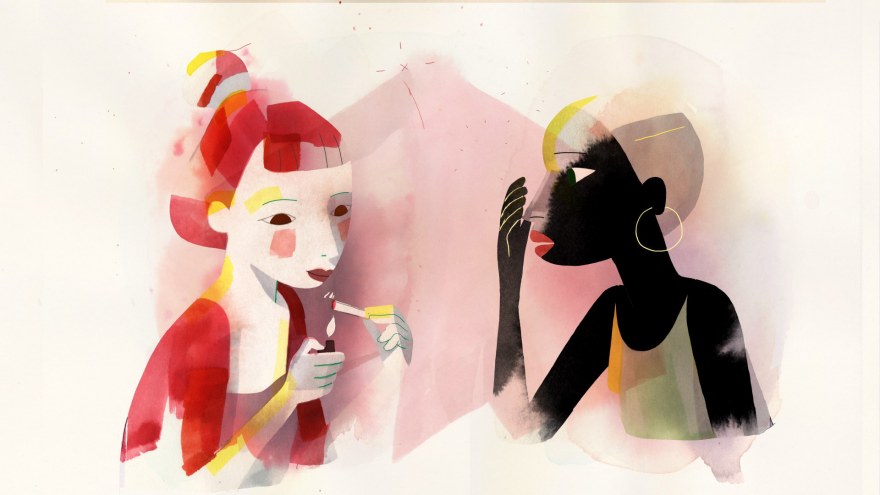Tea time with Genius Loci
Interview with Adrien Mérigeau, director of Genius Loci
Tells us a little bit about how your film, Genius Loci, came to be.
I began writing Genius Loci around 2013-2014, in Ireland while making Song of the Sea. My initial intention was to make a film about leaving behind, in the sense of leaving what we know and are familiar with for something unknown, where things change state, from cultural to natural, or functional to wild, through accidents, excess, break-ups, right at the moment when their very essence comes into question and we’re in the dark, asking questions and searching for answers. I was interested in the unpredictability of chaos and our relationship to things when they completely lose their usefulness and exist for no reason. I also took inspiration from the musical practice my parents, Martine Altenburger and Lê Quan Ninh, have developed around the composer John Cage’s philosophy, whereby music is defined through listening. We could consider the complete sound dimension, of a city for example, as a single musical unit if we listen to it as such. This transformation of sounds into music through our way of listening is basically what I wanted to talk about in my film. There is a meditative, transcendental approach in this detachment from the essence of things that interested me, as if contemplating chaotic movements made up a vast, living canvas, calling up a sort of spiritual unity. My film is built around a character who has a direct link with just such a spiritual unity, a source of mystical inspiration – which comes from the Latin word genius – which allows her to move quite self-assuredly within her precarious, even hostile, circumstances until she realizes she has absolutely no control over them.
The film seems to follow an inner path, and very poetically gives glimpses of the character’s anger, confusion and sensitivity. How did you work to give a visual quality to what Reine is experiencing?
I made sure that we staged the film like a sketchbook, where the compositions go from very minimalist to very elaborate; there are numerous points of view in the same shot, and some things remain line drawings while others are in color. I wanted the spontaneous, human side of a sketchbook to be perceivable, the notes inside and its intrinsic cohesiveness despite the jumble of ideas. In order to create a certain distance between the character Reine and her surroundings, I worked with inks and watercolors to color the animation, creating a constant movement of matter which might bring to mind the quality of Super 8 films. That type of film led to creating films that were a bit blurry and very close to their subjects, engaged in scenes of normal life one after another without well-thought-out editing or logical connections. That gave the impression of meandering through the scenes, watching only their movement without their context, and created a distant, affective gaze on their subjects that really suited my short film. I also frequently superimposed urban scenes and wild elements in order to bring to mind the link between urban chaos and nature. Lastly, it was important for me to work on paper, since traditional drawing, unlike digital, requires concentration and a meditative approach in one’s gestures, which helps me maintain a direct, affective connection with the element I’m drawing.
Can you say a little bit about the animation technique you used?
Brecht Evens and I worked on the storyboard and the staging using pens on paper, exchanging ideas for the shots and compositions to add to the film’s scenes. The animation was drawn on paper for the freer scenes, and using the program TVPaint for the more technical scenes. Céline Devaux also created a scene for the film using her personal technique of scraping material on transparent plastic, directly on film. All of the animation was then printed on paper and colored with inks on watercolor paper using a light table and separating the layers of color which were then superimposed in After Effects. I left the characters that slight transparency that ink colors give, but still kept the surrounding texture of paper. This technique already lent a lot to the image and we didn’t need to add many details to give it a finished look. So the scenery in this film is often minimalist.
Which films did you draw from?
Yuris Norstein’s Hedgehog in the Fog, Tarkovsky’s Stalker , Save Me by Stuart Hilton, When the Day Breaks by Wendy Tilby and Amanda Forbis, Harmony Korine’s Gummo and Masaaki Yuasa’s Cat Soup are a few.
Have you discovered any advantages that the short film form offers?
The short form allows me to write more intuitively and experimentally, where I try to develop a unique, consistent cinematic language, without worrying too much about the technical aspects of the script and narrative apparatus. I very much liked working in this manner as it was directed by the impact and lifespan of the ideas and by a very open, direct and flexible meditative process of creation. French public financing and the system of seasonal work allowed us to buy time and therefore significant artistic freedom. That and the fact that there isn’t really an economy of short films, and therefore no real pressures tied to earnings or target demographics. Short films are an incredible domain for experimentation and we are lucky enough to be to celebrate them thanks to valued international festivals like the one here at Clermont-Ferrand. Thank you!
Genius Loci is part of National Competition F11.








